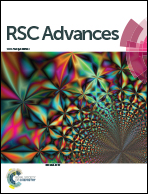Significantly enhanced thermoelectric performance of Cu-doped p-type Bi0.5Sb1.5Te3 by a hydrothermal synthesis method†
Abstract
Cu-doped p-type Bi0.5Sb1.5Te3 compounds have been prepared by a facile hydrothermal method. X-ray powder diffraction analysis shows that the lattice parameter decreases with the Cu content, indicating that Cu+ ions are distributed on the crystal site of Bi/Sb, which is further confirmed by the p-type conducting behavior of the Cu-doped Bi0.5Sb1.5Te3. With the addition of Cu, the hole carrier concentration increases, and meanwhile the lattice thermal conductivity decreases. Furthermore, the greatly raised hole carrier concentration effectively suppresses the bipolar effect, which is beneficial for improving the thermoelectric properties. A dimensionless thermoelectric figure of merit (ZT) value of ∼1.2 at room temperature is achieved for the sample with 0.6 wt% Cu (nominal composition), and the ZT value increases with the temperature to ∼1.5 at 150 °C. Cu-doped Bi0.5Sb1.5Te3 samples exhibit most excellent thermoelectric performance among the presently available (Bi,Sb)2Te3-based materials, implying great potential as near room temperature thermoelectric materials.



 Please wait while we load your content...
Please wait while we load your content...